There’s something about Thailand that wows a visitor’s emotions. Every year, surveys by the Tourism Authority of Thailand (TAT) and independent groups show that tourists find Thai culture genial, gracious and friendly. In an era of processed lifestyles, the disarming warmth of “Thainess” refreshes the soul and prompts people to return.
Thailand’s renowned hospitality grew from traditional customs that still shape modern Thai life, bind the land’s diverse cultures with core values, and imbue activities with gentle zest. Thainess is an intangible heritage – and an attraction in itself.
Initiation Upon Arrival
An initiation into Thai ways (withi thai) greets many a guest at check-in. Arrivals are often ushered by immaculate hotel staff to a bench of carved wood with silk triangular cushions to the strains of traditional music.
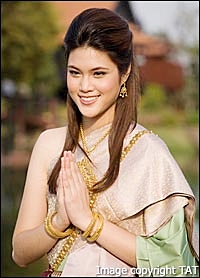
Bowing graciously, the hosts present a garland of fragrant jasmine, a welcome soft drink of local herbs or fruits and a cold towel infused with lemongrass. Such exquisite courtesies are conventional here.
Cultivation of Thainess
Convivial charm is no accident. Thais cultivate and label the traits of Thainess (khwaam pen Thai). Codes of conduct derive from Buddhism, relaxed rural life or court etiquette.
This heritage accrued during the Siamese kingdoms of Sukhothai, Ayutthaya, Thonburi and Bangkok, and was recorded in official chronicles, manuals of folk wisdom (phum panya), literary epics such as ‘Khun Chang Khun Phaen’, and the central text about Thai cosmology, ‘Trai Phum Phra Ruang’. Over recent decades, notions of Thainess have continued to develop as a part of national identity.
Visitors encounter the Thai frame of mind in ordinary interactions, and at extraordinary events of pageantry, in the crafting of cultural symbols, and even in the sharing of a meal and refreshments. Generalizations about any culture always have exceptions, but Thais themselves constantly use these definitions of their national character.
THAI WAYS Politeness
The most famous gesture of Thainess is the wai – a bow with palms pressed together in greeting, respect or reverence. Thais navigate their social hierarchy with different levels of wai. It is one part of a complex physical etiquette (marayaat) that Thais learn as children.
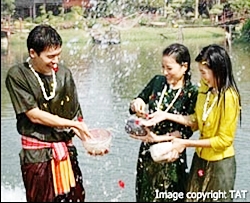
Notice how softly most Thais walk and talk. Social juniors pass objects touching left fingertips to right elbow, a genuflection often done by servers in restaurants and spas. Seniors also get to start a meal first, enter a room first or be ushered to a seat. Younger Thais dip their head when passing elders or people of rank in a literal nod to seniority.
Settings involving the most revered institutions of Buddhism and monarchy – temples, palaces, ritual occasions – require the most elaborate etiquette. Hence at altars in temples and in throne rooms open to the public, visitors are requested to sit pub peab-style, with feet tucked behind. Before royalty, senior monks and important elders, Thais may prostrate (kraab) themselves in a flowing motion, bringing knee, hip then elbow to the ground face down and raising their hands above the head in a deep wai.
Kindness
Thai values in general emphasize kind treatment of others, and many are named with reference to the heart (jai). Visitors experience many acts of courtesy and consideration.
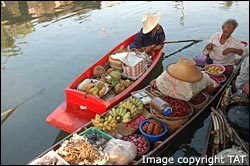
These come from nam jai (water from the heart) – an instinctive thoughtfulness that ‘flows’ naturally from the heart, whether proffering the best seat or inviting strangers to join a meal. An old tradition of placing jars of drinking water beside the gate for passersby finds a modern echo in the free water provided in some shops and food courts.
Buddhism teaches compassion (metta). This ‘loving kindness’ emerges in the spontaneous assistance visitors often encounter, as well as in healing. Metta is an important ingredient behind Thailand’s success with wellness spas, medical treatment and retirement care. When Thais do traditional massage, they massage with metta.
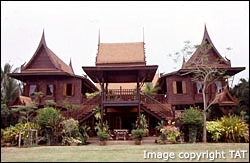
Kreng jai (cautious heart) explains actions that may mystify some non-Thais: preferring to say “yes” rather than “no”; hesitating to interrupt; smiling through crises. The wish not to disturb, offend or impose comes from meaning well, maintaining harmony and the perceived politeness of being indirect, though it can create unexpected contrasts. To foreigners used to directness, kreng jai is the cultural quirk most likely to provide startling anecdotes – along with the preoccupation of saving face. These kinds of kindness combine in an overall attitude of patience, tolerance and acceptance — all keys to the overall goal of most Thais: happiness.
Carefree
Thais wear their serenity lightly. The best known Thai phrase, “mai pen rai”, means “never mind” or “don’t worry”. Heard all the time, these little words reduce stress, defuse tempers and make amends whenever things go awry. People say it about everything from minor bumps, table-top spills or inconvenient errands right up to philosophical detachment from the sufferings of life.

Think of it as immunity from emotional over-reaction. Being jai yen (cool hearted) – which incorporates such qualities as patience and tolerance – helps Thais recover from calamity without losing poise. In the scale of the universe, nothing really matters, so a smile and mai pen rai makes things feel all right.
A smile is effective enough in Thailand but real efficiency comes from infusing situations with fun. The humour and larking that helped villagers unite to gather the harvest remains a vital force in Thai life. Sanuk is a “sensibility for play” that goes beyond the joyfulness of festivals into the effervescent bonding of friends, families, colleagues – and strangers. It’s not just about laughing along, but about companionship, contentment and presenting a happy face to the world.
Between tasks, as between harvests, Thais cherish life’s intervals as occasions to feel sabai – to relax, make things easy, and delight in the senses. Thai spas and interior design draw heavily upon this wish. Sabai also inspire an unhurried pace of life; seats styled to encourage reclining; convenient supplies of goods and snacks; a prevalence of aromatic flowers and herbs; and a preference for cool shade in this hot climate.
WAY OF LIFE
Thai ways find their most authentic expression in traditional activities and attractions. Increasingly, tourist accommodation brings aspects of Thainess into the architecture, setting and involvement with the community and culture. More hotels and tours are offering ways to sample Thainess through activities such as crafts, dance, cooking, meditation, planting rice or making merit.
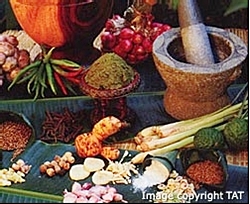
As Thailand modernizes, some seek to preserve heritage buildings and rural environments. In parallel, people wish to conserve the accumulated folk wisdom (phum panya) of traditional masters, artisans, healers and performers. Historically an oral culture, Thai folk wisdom is increasingly codified as a heritage and resource for future generations, notably in herbalism, cookery, dance and martial arts such as muay Thai — Thai kick boxing. This provides more ways for visitors to interact with the culture, and also enables urban Thais to reconnect with their roots.
SHARED VALUES, LOCAL VARIANTS
Thai values are a kind of social glue. They bind traits shared by otherwise disparate ethnicities or regions. Thainess also embraces aspects of different traditional lifestyles found around the kingdom.
VILLAGE & MARKET
Many iconic Thai symbols unsurprisingly hail from the Central Plains around Ayutthaya and Bangkok. Floating markets focus many elements of the bygone riverine lifestyle: canal villages served by boat vendors, orchard workshops turning produce into delicacies, herb gardens (suan krua) for food and healing, homestays in teak stilt houses with rooflines soaring skyward.

The wooden stilt houses of other regions vary in layout, roofline and climatic needs, but their main floor plans all reflect similar family structures. Flexible prefabricated construction also typifies the Thais’ adaptability and mobility, a quality also seen in vendor stalls and umbrella-sheltered markets like the northern bazaars (kaad mua).
FOOD & FARMING
Every region has plantations and orchards – from longan, lychee, mandarin oranges and strawberry in the north to rubber in the south, sugar palm in the Central Plains and toddy palms in coastal areas – but Thai village traditions were shaped most by rice cultivation. The loose white rice of the plains and south complements the taste of curries: rich and aromatic in central cooking, pungent and fiery in the Thai peninsula.

Sticky rice instead dominates the ambrosial dips and dishes of the north and the rustic spicy food of Isan, where the village traditions survive most intact. All regions match fresh herbs and raw vegetables with pastes from freshwater or coastal fisheries. Cooking classes, fishing trips and visits to farms and markets help reveal the diversity and consistencies of Thai cuisine.
CRAFTS & WEAVING
Basketry, carving and hand-loomed textiles reveal the particular character of each place, but are usually variations on collective themes. These and other crafts have evolved as souvenirs and decor objects of great sophistication. Meanwhile, tourists can sample the artisan life in workshops: metalworking and mask making in the plains; silk looms and pottery kilns in Isan; batik printing and shadow puppet carving in the south; tribal textiles, indigo dying and mulberry paper making in the north.
STUDY OF SKILLS
Certain places have emerged as centres to teach particular Thai skills to visitors, though many others have spread countrywide. Dance is the most diverse, from khon in Bangkok and Manohra in the south to fon leb nail dances up north and Isan’s boisterous serng and morlam.
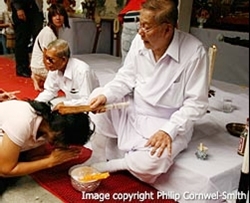
Muay Thai grew from fighting genres like muay Chaiya from the South and muay Khorat from the boxing heartland of the Northeast, Isan. Separate styles of Thai ancient massage can be found in Chiang Mai and Bangkok. Meditators find different schools of thought at classic temples in Bangkok, remote forest temples in the north and Isan, or the progressive dhamma hermitage at Chaiya in the south.
RITUAL & FESTIVAL
Studying Thai skills gives insights into the symbolism and practice of Thai ways. Rituals might include a wai khru to pay respect to masters of dance or boxing, launching a floral krathong float or northern paper lantern as an offering, or the tying of white wrist-strings in the bai sri blessing rite of Isan and the north. Rituals often intertwine with festivals, which provide a chance to see elements of local culture combine: dance and textiles, crafts and music, markets and food.
INCLUSIVENESS
Connecting these threads, the national language evolved from Central Thai. Spoken by all, it makes the concepts of Thainess understood throughout a land with dozens of native tongues.
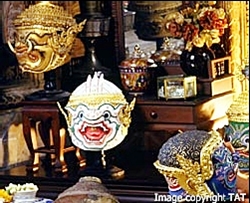
Thainess, too, is a common denominator. It has evolved to include cultures of Thailand’s minorities, notably Chinese, Lao, Mon, Khmer, Shan, northern hill tribes, Moken and Muslim Malay. Differences in religion or ethnicity have their space for expression, and can be bridged by secular values of Thainess held in common, such as etiquette and aesthetics, seniority, sabai and sanuk.
THAI AESTHETICS
Identifying things Thai can be clearer when comparing how Thais adapt influences from outside. Eclectic Thailand lies at a historic international crossroads. Evolved over centuries of exchange with other cultures, Thailand’s hybrid forms reveal the local difference: a distinct Thai style.
In architecture and design, Thai aesthetics elongate classic forms with delicate grace. The repertoire of Thai motifs (lai Thai) turns images of auspicious nature and mythology into fanciful shapes and abstract patterns. These ethereal lines reappear in many other arts: the threading of garlands, the carving of fruit, the costume and postures of dance.
Lai Thai, along with indigenous materials, forms the basis of both ancient crafts and contemporary Thai design. Thai colour-sense veers from subtle earth tones and natural dyes to a palette of vivid jewel hues. Other style traits include playfulness and a friendly dose of cuteness, infusing Thai products with sanuk.
Thainess stems from the culture and is absorbed from such an early age that for most Thais it is utterly effortless. These values give Thais a sense of togetherness and purpose, and explain the warmth of their welcome.




